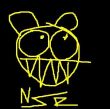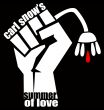| btimm |
|
23 Feb 2010 11:33 | Quote |
Joined: 14 Dec 2009 United States  Lessons: 2 Licks: 1 Karma: 16 
|
On the chord chart, I saw that there is no F minor open chord. The F chord is as follows:
e:-1--
B:-1--
G:--2-
D:---3
A:x
E:x
So those notes are F, A, C, and F again. I don't understand why there isn't a minor chord that would just change the A to an Ab and it would be played as follows:
e:-1--
B:-1--
G:-1--
D:---3
A:x
E:x
|
| gx1327 |
|
23 Feb 2010 12:40 | Quote |
Joined: 20 Sep 2009 United States  Karma Karma: 9 
|
i never understood why F was considered an "open chord". when i play an F i usually just play the barre chord at the 1st fret. in that case, you are correct. look at the "open" F major chord. it should look familiar because if you played
1
1
-2
--3
--3
1
it's just your standard 6-string major barre chord.
and if you remove the middle finger and leave your index finger barred you get
1
1
1
--3
--3
1
which is the typical 6-string minor barre chord.
>>> i think that the reason that they consider the F an "open" chord is becasue you can play it with your fingers without having to barre all 6 strings, for those players who have yet to go from open chords to barre chords. if you think about it, you can play
1 index
1 middle
2 ring
3 pinky
x
x
it might be harder to play that 1/1/1/3/x/x with your fingers without having to barre? |
| JustJeff |
|
23 Feb 2010 13:11 | Quote |
Joined: way back United States  Lessons: 2 Karma: 21 
|
Well, the notes in an Fm chord are: F, Ab, C. Let's look at our open strings: E B G D A E.
Do any of those match? nope... no open chords.
Fm maj7 chord though... F, Ab, C, E
Play this as:
x331x0
Technically, that's an open chord... |
| btimm |
|
23 Feb 2010 14:00 | Quote |
Joined: 14 Dec 2009 United States  Lessons: 2 Licks: 1 Karma: 16 
|
Okay, I did not phrase my question correctly, since I did not fully understand what an open chord was. Thanks for that clarification Jeff! I guess I was just wondering why the F chord I have above does not have a corresponding Fm chord that I thought would be in the guitar chords section of this website. Seems like it should be there unless I am missing something about what I thought was an Fm chord above. The 1113xx form. |
| Phip |
|
23 Feb 2010 14:16 | Quote |
Joined: 23 Dec 2007 United States  Lessons: 1 Karma: 45  Moderator Moderator
|
Btimm,
actually if you go the the "chord name" tool and punch in your xx3111 it WILL show as Fm.
give it a try
Phip |
| btimm |
|
23 Feb 2010 16:10 | Quote |
Joined: 14 Dec 2009 United States  Lessons: 2 Licks: 1 Karma: 16 
|
Phip, thanks for that. I didn't look there, I was just checking the variations in the 'Guitar Chords' tab. I will check out the chord name tool more when I have questions now, thanks! |
| Phip |
|
23 Feb 2010 17:18 | Quote |
Joined: 23 Dec 2007 United States  Lessons: 1 Karma: 45  Moderator Moderator
|
yeah btimm, it's a useful tool. remember this...if you are playing the proper notes that make up a chord then you are either playing a less popular configuration of that chord or you just invented a new way to finger. (as long as you don't add extra notes, then it's a variation of the original chord, but a chord none the less.) the basic rules of chord structure apply no matter how you choose to assemble the notes. so when i don't see a pattern in the chord tool and i'm sure i'm not making a mistake i go to the chord name too and check myself on that.
Phip |
| gx1327 |
|
24 Feb 2010 08:47 | Quote |
Joined: 20 Sep 2009 United States  Karma Karma: 9 
|
JustJeff says: Well, the notes in an Fm chord are: F, Ab, C. Let's look at our open strings: E B G D A E.
Do any of those match? nope... no open chords.
well one thing i've noticed is that F major is often taught along with the open chords. i've seen it on a few different websites, they teach you CAGED, and then they teach you F, but they only teach you to play 1123xx (high to low). i never understood that. granted it's not an open chord, but it's taught as a beginner chord.
but i'm thinking the reason it's taught along with CAGED is because you can use your fingers to create F major without having to jump into barring. just my theory. |
| JustJeff |
|
24 Feb 2010 09:02 | Quote |
Joined: way back United States  Lessons: 2 Karma: 21 
|
The F major chord is popular for the keys of C major and F major. It's a common chord and it needs to be taught, the xx3211 (low to high is usually the convention for this sort of layout) is a simpler way of fretting it.
Though, another reason why it's taught is because if you think of the E major chord, it's 022100. The F major chord is 133211.
Do you see the pattern? Do you see the relationship between the E and F.
Here's a hint... there is no E#, so a half step up from E is F. |
| carlsnow |
|
24 Feb 2010 13:51 | Quote |
Joined: 29 Apr 2009 United States  Lessons: 2 Karma: 23 
|
Phip says: ctually if you go the the "chord name" tool and punch in your xx3111 it WILL show as Fm.
quite true BUT some advice.
the chord name gen works like all chord name gens (i would suppose) so at times it will give you (should anyways) at least 3 or 4 chord names for the same fingering, when moving beyond basic maj, min, aug, dim chords. this is due to that fact that many fingerings can "mean" or can be written in different ways do to an undefined 1 (root) OR what i cal dealers choice. say you have what ya think is 'this crazy new chord' ... its been played, trust me, and it may have many names (root definition again).
this is very useful! no kidding! if i score something(tv) or write a song with some oddball chords i long for congruency, Dig? So if the tune is in 'E' and the chord can be named using E, A, or B as the root i will choose the 'E' as it is more easily read and understood that way.
yeah its strange---but very true
hope that helped someone...
RAWK!
Cs
Global Disclaimer :
Carl Snow is an old, jaded & slightly bitter old man who cannot be held accountable for anything, much less his opinionatedly opinionated opinions or those of his imaginary friends. We sincerely apologize if this Carl Snow and/or its behavior have infected you or others with its ugly brain and its juices.
|
|
|





